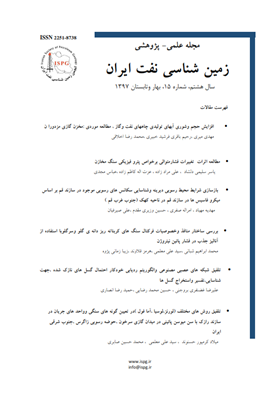تلفیق روش¬های مختلف (لورنز، لوسیا، امافول) در تعیین گونه های سنگی و واحدهای جریانی در سازند رازک با سن میوسن پایینی در میدان گازی سرخون، حوضه رسوبی زاگرس، جنوب شرقی ایران
محورهای موضوعی :محمدحسین صابری 1 , میلاد کرمپورحسنوند 2 , سید علی معلمی 3
1 - دانشگاه سمنان
2 - دانشگاه سمنان
3 - پژوهشکده ازدیاد برداشت از مخازن نفت و گاز
کلید واژه: سازند رازک واحدهای جریان نوع سنگی روش لورنز روش لوسیا روش آمافول ,
چکیده مقاله :
یکی از اساسی ترین مراحل سرشت نمایی مخازن هیدروکربنی شناسایی گونه های سنگی است. در مطالعه حاضرهدف مقایسه روش های مختلف در تعیین گونه های سنگی و شناخت چگونگی توزیع واحد های جریانی هیدرولیکی در جهت ارزیابی کیفیت مخزنی سازند رازک با لیتولوژی کربناته ماسه سنگی، مارن و انیدریت به سن الیگوسن تا میوسن پایینی می باشد. در این تحقیق 84 مقطع نازک میکروسکپی، نتایج آزمایشگاهی تخلخل، تراوایی و منحنی های فشار مویینه از 46 متر مغزه حفاری در یکی از میادین مهم جنوب شرق ایران، مورد بررسی قرار گرفت و مطالعات پتروگرافی در جهت بررسی تغییرات رخساره ای بخش مخزنی سازند رازک منجر به شناسایی هشت ریز رخساره (MF1 پکستون و وکستون در عمق 2829، متری MF2 پکستون گرینستون در عمق 2844 متری MF3، وکستون مادستون در عمق 2856 متری،MF4 گرینستون در عمق 2859 متری،MF5 مادستون وکستون در عمق 2848 متری، MF6 مادستون در عمق 2838 متری، MF7 وکستون مادستون در عمق2840 متری، MF8 وکستون ماسه ای در عمق 2831 متری) در محیط رسوبی محصور یا پلت فرم کربناته و رمپ هموکلینال و سیستم آواری رودخانه ای شده است. به منظور تعیین گونه های سنگی و ارزیابی واحد های جریانی براساس نتایج آنالیز مغزه، ابتدا با استفاده از روش لوسیا چهار رده پتروفیزیکی شناسایی گردید که رده پتروفیزیکی شماره یک بهترین کیفیت مخزنی و رده شماره چهار ضعیف ترین کیفیت مخزن را دارد.همچنین واحدهای جریانی با استفاده از روش های آمافول و لورنز شناسایی و تفکیک شدند. بر اساس روش آمافول در بخش مخزنی سازند رازک، هفت واحد جریانی شناسایی شده، که واحد جریانی شش و هفت (FZI6,FZI7) بهترین و واحد جریانی یک (FZI1) ضعیفترین بخش مخزنی است. در روش لورنز واحد جریانی شش (HF6) پرسرعت ترین و واحد جریان یک (HF1) ضعیفترین بخش مخزنی در بین شش واحد جریان شناسایی شده است . همچنین بر اساس آنالیز منحنی های موئینگی شش گونه سنگی تفکیک گردید، که بر اساس آن گونه سنگی شماره پنج و شش (RT5,RT6) بهترین کیفیت مخرنی را دارا می باشند. همچنین با استفاده از کراس پلات های نرم افزار ژئولاگ مشخص شد لیتولوژی اصلی این بخش ماسه سنگ به همراه رس می باشد و وجود گاز در این سازند باعث انحراف نمونه ها به سمت شمال غربی کراس پلات شده است. در نهایت با ترکیب اطلاعات مختلف مشخص گردید، سازند مخرنی در میدان مورد مطالعه دارای پنج نوع گونه سنگی می باشد که گونه سنگی شماره چهار بهترین کیفیت مخزنی و گونه سنگی شماره پنج بزرگترین بخش مخزنی و بهترین واحد جریانی واحد شماره شش می باشد.
One of the most important stages in the hydrocarbon reservoirs morphology is the identification of rocky type. In order to construct an efficient and correct model of a hydrocarbon reservoir, identification of rock types is one of the essential parameters in reservoir modeling. and its consequences are found in the identification of rock types. The aim of this study is to compare different methods of determining rocky type and understanding the hydraulic flow unit distributions in order to assess the quality of reservoir of Razak Formation with sandstone carbonate lithology, marl and anhydrite to San Oligocene to lower Miocene. In this research, the experimental results of porosity, permeability and capillary pressure curves for 84 samples with porous microscopic sections Related to a 46-meter drill bit in one of the important fields of southeast of Iran were analyzed. The petrographic studies were conducted to investigate the changes of the features in the reservoir section with Razak formation and resulted in the identification of eight microfeatures( The MF1 packstone and Wackstone are at a depth of 2829 meters- The MF2 is the grinstone packstone at a depth of 2844 meters-the MF3 is the wackstone mudstone at a depth 2856 meters-the MF4 is the grinstone at a depth 2859meters –the MF5 is the mudstone wackstone are at a depth2848 meters – the MF6 mudstone at a depth of 2838 meters the MF7is the wackstone mudstone at a depth 2840 meters- The MF8 is a wackstone with sandstone depth of 2831) meters- in open Marin lagoon and fluvial clastic systems. In order to determine the rocky species and assess the flow units based on the core analysis results, four petrophysical classes were identified using the Lucia method. The petrophysical category number 1 has the best reservoir quality and the fourth category has the weakest reservoir quality. Also, the flow units were identified and separated using Amalufee and Lorenz's methods. Based on the Amalufee method, in the reservoir section of the Razak Formation, seven flow units have been identified, the sixth and seventh stream units were the best and one was the weakest reservoir segments among the seven units of the flow. Also, based on the analysis of capillary curves, six rocky species were distinguished, based on which the rocky type number five and six have the best quality. Also, using Geology software cross-sections, it was revealed that the main part of this section is sandstone with clay. The presence of gas in the formation causes cross-sectional deformation of samples to the northwest cross-platform. Finally, with the combination of various data, it was found the fossil formation in the study area has five types of rock in which the number 4 rock has the best quality of reservoir and rock number 5 has the largest reservoir and the unit number six is the best.
